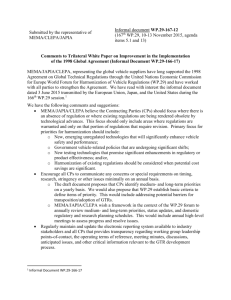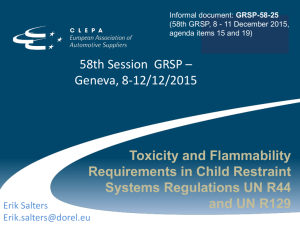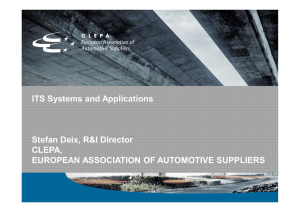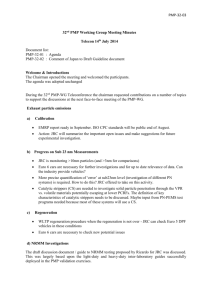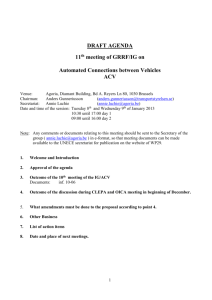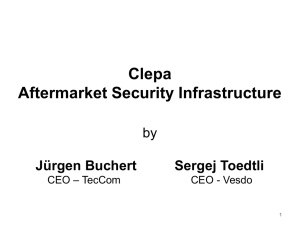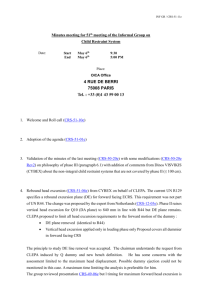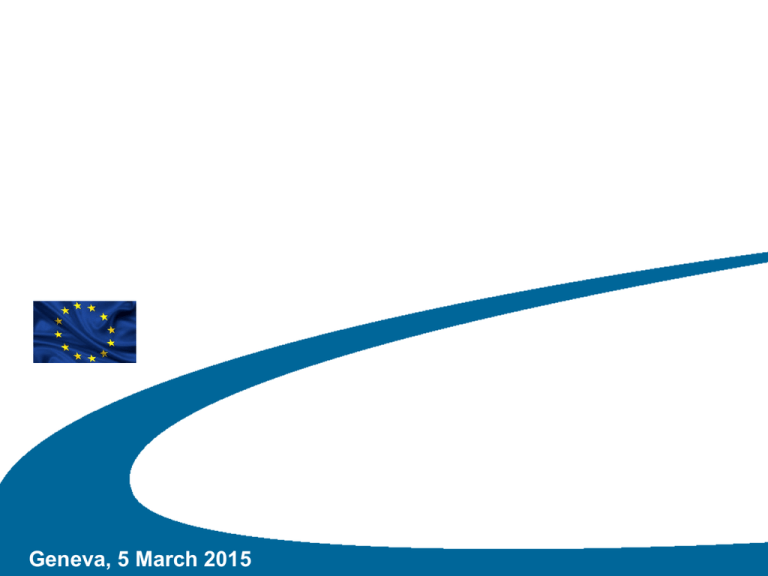
The Future Networked Car
Paul Schockmel CLEPA CEO
Geneva, 5 March 2015
The European Association of Automotive Suppliers
109 Corporate members
23 Member Associations
18 billion € R&D per year
5 million employees
600 billion € sales
Partner of the EU and the UN
Our vision is for the European Automotive Suppliers to be the leading provider of highly
efficient and sustainable mobility worldwide
Our mission is to increase the competitiveness of the European automotive suppliers’ industry
and drive its sustainable growth while enhancing wealth and employment in Europe
Copyright © 2015 CLEPA. All rights reserved. www.clepa.eu
Relevant Drivers for Mobility Systems
Urbanization
Within 2030 there will be more than 40 Mega-Cities
A complete re-think of urban mobility will be required
Smart-Cities and Smart Transportation Systems
Global Growth of Middle Class
From 1998 to 2018 the Middle Class in Emerging Countries is growing by 255%
The access to certain goods like cars will grow as well
Relevant Drivers
for
Mobility System
Regulatory Framework: decarbonization of transport, Air Quality &
Road Safety
Severe legislation will drive the technology choices of Car Manufactures
Governments will support the pioneering phase of zero emission vehicles by mean of
heavy incentives
Vision Zero will support both Autonomous and Cooperative Driving together with ADAS
systems
Consumers attitude evolution
Gen Y shows poor interest towards private cars and even driving license
Car sharing will grow together with new business models offering services
more than traditional goods
Ageing society
Copyright © 2015 CLEPA. All rights reserved. www.clepa.eu
Disruptive Technologies
Internet of Things
Cloud computing
Autonomous Driving
New materials
Mobile Internet
Automation of knowledge work
Advanced robotics
Next generation genomics
Energy Storage
3D Printing
Advanced oil and gas exploration and
recovery
Renewable Energy
Disruptive Technologies:
Advances that will transform life,
business, and the global economy
Source: (McKinsey Global Institute – May 2013 – Disruptive Technologies:
Advances that will transform life, business and the global economy)
Copyright © 2015 CLEPA. All rights reserved. www.clepa.eu
4
Benefits of autnomous driving
The Autonomus Driving impact in
USA
Productivity
Improvement
507 bn$/y
Road accidents
reduction
Source: Morgan Stanley
488 bn$/y
Total Saving
1302 bn$/y
Fuel Economy
158 bn$/y
Copyright © 2015 CLEPA. All rights reserved. www.clepa.eu
Additional
Productivity due to
traffic avoidance
138 bn$/y
Additional fuel
saving due to traffic
avoidance
11 bn$/y
5
Automated Driving: enabling technologies
Perception
Information
Radar
Camera (mono & stereo)
Lidar
Ultrasonics
….
Vehicle 2 X Communication:
IEEE 802.11p
LTE Direct
BTLE
VLC (Visibile Light Communication)
Local Dynamic
Map
Actuation
Path Planning
Vehicle Control
Positioning
Data Fusion
Differential GPS (SBAS, GBAS, RTK,..)
Sensor Refinement (Sensor model, feature
extraction)
Gyro, Accelerometer, Odometer fusion
Visual Odometry
SLAM (Simultaneous Localization and
Mapping)
…
Object Refinement (Data Alignement &
Association)
Situation Refinement (Situation & Behaviour
identificaiton, Relatioships, trajectories prediction)
Supervisor (risk assessment, action planning,
decision making)
Copyright © 2015 CLEPA. All rights reserved. www.clepa.eu
Vienna Convention - Europe
The Vienna Convention stipulates that a vehicle needs a driver and that every
driver shall at all times to be able to control his vehicle
The governments of Germany, Italy, France, Belgium and Austria have submitted
an amendment to the Convention
The amendment would allow a car to drive itself, as long as the system
“can be overridden or switched off by the driver”
A driver must be present and able to take the wheel at any time
Copyright © 2015 CLEPA. All rights reserved. www.clepa.eu
Final Step: integration between autonomous and cooperative
driving
Copyright © 2015 CLEPA. All rights reserved. www.clepa.eu
From just connected to cooperative vehicle use cases
Connected
Source: workshop on ITS Architecture for NL Sep 2014
Eco Route
Planner
Rerouting
15 min
Intermodal Route Planner
25 Km
Traffic Information Service
EV Charging Point Planner
Smart Parking Assistant
1 min
1 Km
Probe Vehicle Data
Navigation
In Vehicle Signage (IVS)
Green Wave
Shockwave Damping
10 s
100 m
Priority Request
Incident Warning
Road Works
Warning
(RWW)
Merging Assistant
1s
Speed and Lane Advice (SLA)
Stopping Behaviour Optimization
Slow Vehicle
Warning
Red Light Violation
Warning
Cooperative Adaptive Cruise Control (CACC)
Electronic
Emergency Break
Light
Cooperative
Safety
Traffic Flow
Copyright © 2015 CLEPA. All rights reserved. www.clepa.eu
Environment
Comfort
10 m
Current Situation in connectivity
Today the automotive connectivity is dominated by aftermarket
devices;
Rolling out new infrastructure is expensive, slow, and incomplete in
coverage;
Regional differences may hinder interoperability;
Accompanying measures to bridge the communication gap towards
increased penetration of systems is required;
Copyright © 2015 CLEPA. All rights reserved. www.clepa.eu
Objectives for connected vehicles
Increase market penetration with interoperable communication (DSRC and 4G-LTE) units;
Ensure safety, reliability, privacy and security;
Enable realtime ITS service provision;
Enable a vivid ecosystem of ITS services by third parties;
Enable early deployment recognizing customer interest;
Focus on functionalities build on solid business cases;
Enable access to sensor data by appointed authorities.
Increase market share of connected and communicating vehicles
Open in-vehicle platform architecture
Copyright © 2015 CLEPA. All rights reserved. www.clepa.eu
THANK YOU !
www.clepa.eu

